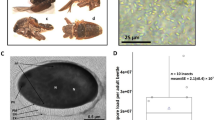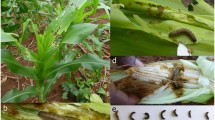Abstract
Microsporidia are unique fungi that exist as obligate intracellular parasites. Approximately 40% of the known microsporidian strains infect various insects. Due to their high host specificity, microsporidia have potential use as powerful biological pesticides. Here, we analyzed microsporidian strains isolated from the common cutworm, Spodoptera litura Fabricius (Lepidoptera: Noctuidae) of Japan and Taiwan, which is considered a pest insect. Two experiments were performed: a comparison of spore size and a phylogenetic analysis using small subunit ribosomal RNA gene sequencing. We then estimated the flight routes of S. litura by using the phylogenetic relationships of the isolated microsporidian strains as a marker. An analysis of spore size indicated that the test strains comprised three groups: Pleistophora, Nosema or Vairimorpha, and Trachipleistophora or Vavraia. The results of the phylogenetic analysis suggested a classification into five genera, including Vavraia. The genus Vavraia was first detected from lepidopteran insects in Japan. We estimated the sources and flight routes of S. litura using phylogenetic data for the genera Nosema and Trachipleistophora. In this study, we used microsporidia as a novel marker to estimate sources and flight routes of S. litura from Ogasawara and Southern China to mainland Japan, demonstrating the usefulness of this approach.



Similar content being viewed by others
References
Bhat SA, Bashir I, Kamili AS (2009) Microsporidiosis of silkworm, Bombyx mori L. (Lepidoptera- Bombycidae): a review. AJAR 4:1519–1523
Bjørnson S, Oi D (2014) Microsporidia biological control agents and pathogens of beneficial insects. In: Weiss LM, Becnel JJ (eds) Microsporidia: pathogens of opportunity. Wiley, Iowa, pp 635–670
Felsenstein J (1985) Confidence limits on phylogenies: an approach using the bootstrap. Evolution 39:783–791
Hatakeyama Y, Hayasaka S (2002) Specific amplification of microsporidian DNA fragments using multiprimer PCR. JARQ 36:97–102
Hatakeyama Y, Kawakami Y, Iwano H, Inoue T, Ishihara R (1997) Analyses and taxonomic inferences of small subunit ribosomal RNA sequences of five microsporidia pathogenic to the silkworm, Bombyx mori. J Seric Sci Jpn 66:242–252
Hatakeyama Y, Oda H, Tsunoda R, Imura Y, Maeda T, Xuan TT, Hai TV, Iwano H (2011) Genome profiling implies high genetic diversity in microsporidia isolated from the common cutworm, Spodoptera litura (Lepidoptera: Noctuidae), in Vietnam. Appl Entomol Zool 46:293–299
Huang X, Madan A (1999) CAP3: a DNA sequence assembly program. Genome Res 9:868–877
Itoh M, Sakamaki Y, Tsuda K, Kusigemati K (2007) Comparison of developmental rates and reproductive traits of the common cutworm, Spodoptera litura (Fabricius) feeding on some host plants. South Pac Stud 27:73–82 (in Japanese with English summary)
Iwano H, Kawakami S, Yamamoto Y, Shigano T, Hai TV, Hatakeyama Y (2015) Characteristics of infection to the silkworm, Bombyx mori of microsporidia, Nosema bombycis isolated from the common cutworm, Spodoptera litura in Vietnam. Sanshi-Konchu Biotec 84:237–243 (in Japanese with English summary)
Kawarabata T (2003) Biology of microsporidians infecting the silkworm, Bombyx mori, in Japan. J Insect Biotechnol Sericol 72:1–32
Kumar S, Stecher G, Tamura K (2016) MEGA7: molecular evolutionary genetics analysis version 7.0 for bigger datasets. Mol Biol Evol 33:1870–1874
Lobo ML, Silveira H, Ramos S, Xiao L, Matos O (2006) Characterization of a pathogen related to Vavraia culicis detected in a laboratory colony of Anopheles stephensi. J Eukaryot Microbiol 53:S65–S67
Matsuura H, Naito A, Kikuchi A (1991) Studies on the cold-hardiness and overwintering of Spodoptera litura F. (Lepidoptera: Noctuidae). I. Viability of the insect under low temperatures. Jpn J Appl Entomol Zool 35:39–44 (in Japanese with English summary)
Mochida O, Okada T (1974) A bibliography of Spodoptera spp. (Lepidoptera: Noctuidae). Misc Bull Kyushu nat agr Expt Sta 49:1–110
Murata M, Etoh T, Itoyama K, Tojo S (1998) Sudden occurrence of the common cutworm, Spodoptera litura (Lepidoptera: Noctuidae) in southern Japan during the typhoon season. Appl Entomol Zool 33:419–427
Nishimoto N, Hatakeyama Y, Watanabe M, Takahashi M, Miyake S, Yamamoto Y, Shigano T, Ohbayashi S, Iwano H (2016) Elucidation of genetic diversity of the common cutworm, Spodoptera litura (Lepidoptera: Noctuidae) between indigenous areas in Asia and the islands of Japan. Jpn J Appl Entomol Zool 60:23–31 (in Japanese with English summary)
Okamoto D, Okada M (1968) Studies on the tobacco cutworm, Prodenia litura Fabricius, as an insect pest of the forage crops. Bull Chugoku Natl Agric Exp Stn Ser E2:111–144 (in Japanese with English summary)
Saitou N, Nei M (1987) The neighbor-joining method: a new method for reconstructing phylogenetic trees. Mol Biol Evol 4:406–425
Shigano T, Hatakeyama Y, Nishimoto N, Watanabe M, Yamamoto Y, Wijonarko A, Ohbayashi T, Iwano H (2015) Variety and diversity of microsporidia isolated from the common cutworm Spodoptera litura in Chichijima, Ogasawara islands. J Insect Biotechnol Sericol 84:69–73
Takahashi M, Hatakeyama Y, Imura Y, Nakamura H, Chiba S, Kurimoto N, Miyake S, Yamamoto Y, Enomoto K, Iwano H (2017) Design of a specific genetic marker for the classification of Bacillus thuringiensis. J Insect Biotechnol Sericol 86:21–28
Tamura K (1992) Estimation of the number of nucleotide substitutions when there are strong transition-transversion and G + C-content biases. Mol Biol Evol 9:678–687
Thompson JD, Higgins DG, Gibson TJ (1994) CLUSTAL W: improving the sensitivity of progressive multiple sequence alignment through sequence weighting, position-specific gap penalties and weight matrix choice. Nucleic Acids Res 22:4673–4680
Tojo S, Ryuda M, Fukuda T, Matsunaga T, Choi DR, Otuka A (2013) Overseas migration of the common cutworm, Spodoptera litura (Lepidoptera: Noctuidae), from May to mid-July in east Asia. Appl Entomol Zool 48:131–140
Vávra J, Becnel JJ (2007) Vavraia culicis (Weiser, 1947) Weiser, 1977 revisited: cytological characterization of a Vavraia culicis-like microsporidium isolated from mosquitoes in Florida and the establishment of Vavraia culicis floridensis subsp. n. Folia Parasitol 54:259–271
Vávra J, Lukeš J (2013) Microsporidia and ‘the art of living together’. Adv Parasitol 82:253–319
Vávra J, Kamler M, Modrý D, Koudela B (2011) Opportunistic nature of the mammalian microsporidia: experimental transmission of Trachipleistophora extenrec (Fungi: Microsporidia) between mammalian and insect hosts. Parasitol Res 108:1565–1573
Wittner M, Weiss LM (1999) The microsporidia and microsporidiosis. American Society for Microbiology Press, Washington DC, p 553
Acknowledgements
We are grateful to Naoki KURIMOTO, and Masahiro UCHIKADO of College of Bioresource Sciences, Nihon University, Hiroshi YOKOYAMA of Ikari Shodoku Co., Ltd., and Masaru HOJO of National Institute for Basic Biology for collecting and providing the S. litura. This study was supported in part by a Grant-in-Aid from the Nihon University College of Bioresource Sciences Research Fund for 2016–2018.
Author information
Authors and Affiliations
Corresponding author
Additional information
Publisher's Note
Springer Nature remains neutral with regard to jurisdictional claims in published maps and institutional affiliations.
Rights and permissions
About this article
Cite this article
Imura, Y., Hatakeyama, Y., Takahashi, M. et al. A novel approach using microsporidia to estimate the flight route of the common cutworm, Spodoptera litura (Lepidoptera: Noctuidae). Appl Entomol Zool 54, 185–192 (2019). https://doi.org/10.1007/s13355-019-00611-7
Received:
Accepted:
Published:
Issue Date:
DOI: https://doi.org/10.1007/s13355-019-00611-7




